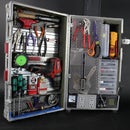Introduction: 3D Printed Motorized Bathroom Sign
I made a 3D printed motorized toilet sign that changes from pants to a dress every 15 seconds. It is free to make and modify.
Bathrooms are complicated business. In the USA, recent transphobic legislation has tried to delegitimize the basic need of trans folk to use a bathroom. Many progressive institutions have thankfully responded by systematically de-gendering their toilet facilities. Here is a sign that might help in such an effort. My sign acknowledges the absurdity of the traditional signs, which fail to recognize that:
- There more than two genders (Discussion)
- That women can wear pants, and men can wear dresses.
- That gender is not related disposal of excrement
A future without gendered bathrooms is is future where all people wait the same amount to time for the bathroom. it is a future where no one is afraid to pee because of who they are. and thankfully, It is a future we seem to be heading towards.
This is a political project. If you don't think politics have a place in making, you are mistaken. Also, the comment section is no place for hate. Keep it calm, keep it kind.
Further Reading
Step 1: Mechanical Design
This design uses a simple crank mechanism that drives the left arm. The left arm has a slot that the crank pin rides in. As the crank spins, it opens the arm in a sine-motion, called harmonic motion. This is ideal as it is smooth and gives both states (pants and dress) equal time. It is also easy to make from a spinning input.
The right arm mirrors the left arm's motion using a simple 1:1 gear system. Both gears are only partial, due to aesthetics and the limited 16° motion of both arms. The gears are centered on the axis of rotation. I used the Gear Generator Script in Fusion 360. It required some math.
Another option would have been some kind of balanced dual pendulum design with electromagnetic impulses from a coil to keep the motion going. This is how the waving cats and other solar powered toys work, but I am not sure I have the engineering chops to make it work. Maybe next time!
Solar Toys Further Reading
Step 2: CAD
This is a tricky thing to design. It is essentially 50% mechanical engineering and 50% graphic design. Not so many tools are good at both things.
I started with the AIGA Symbol signs (Helvetica Woman + Man)I started this project 4 years ago the 2D vector program Adobe Illustrator. This sucked, as I had to print out the design and test in paper each time I wanted it to move.
I eventually tried it in Rhino3D but was frustrated by the lack of mechanical features.
I then moved to Autodesk Inventor, but it is very constricting and difficult to use.
Last week, I exported each part as a 2D DXF file and rebuilt it in Fusion 360. Fusion is free for makers and enthusiasts like you and me. It has mechanical joint support and a friendly (By CAD standards :-) interface.
Here is a video of the last few steps of my design. It is not narrated.
Here is the online version of the CAD which you are free to remix for any not-evil purpose, even if you want to sell these things. Go for it.
Want to learn more? JON-O-TRON has the best mechanical Fusion360 projects I have seen.
Step 3: Find Your Motor
Adding the motor
I used a low-rpm AC microwave oven turntable motor. These are free in broken microwaves or cheap online. They are simply plugged into the wall with no control circuitry needed. They use AC voltage, so very careful as this can hurt.
I was very lucky to find a 3D model of the motor I found. I think these motors are very standardized.
Special thanks to Marco Gregorio on GrabCad for this Microwave Turntable Motor model, and for the sweet GIF above.
Make sure it has the D-shaped shaft and the voltage of your country.(110VAC or 220VAC) The low voltage AC models need an expensive transformer.
If you find an old microwave, look at the bottom. The motor can often be easily removed with a screwdriver.
220V model
110V model
You can also use a servo if you modify the design.
I dream of making a solar-powered version to avoid the wiring hassle. Something like the toy cats that wave forever.
Step 4: 3D Printing
Here is a link to the Thingiverse page.
I printed with no support, no raft, no brim on a FDM machine. It took about 8 hours.
There are many file types on the thingiverse, feel free to remix!
Keep in mind that layer-to-layer adhesion needs to be good because the two arms rotate on very fragile pins. It might be worth using small screws with nylon lock-nuts if you experience difficulty.
Step 5: Adding Crank Wheel Pin
The crank needs a metal pin to function.
- Find a very small nail or a regular paper clip, about 1mm in diameter
- If paperclip, Straighten out the paperclip for a 20mm section (3/4"in.)
- Holding the clip with pliers, heat it over a flame or a stove.
- Press it into the crank wheel, in the small hole. (it is near the flat side of the D-shape)
- Leave 3-5mm (0.1"-0.2" in) protruding through the front face
- Allow to cool, ensure it is straight.
- Trim excess on back or front if needed.
Step 6: Attaching Arms
The two arms are snap-fit into the armpit joints. Ensure the arms are in symmetrical positions before snapping in the second one. Try to avoid removing them, as the pins are super fragile.
I used sandpaper and the edge of a sharp knife to clean the parts before assembly to prevent snags. Keep in mind these pins are extremely weak, and may even be too weak to work if your printer is not calibrated. Small screws and nylon lock nuts would be better, but require drilling or modeling two holes in the arms.
Test the motion. The arms should move symmetrically.
Step 7: Adding Crank Wheel and Motor
The crank wheel with its new metal pin should simply press fit onto the motor shaft. The shaft-hole is slightly tapered for a snug fit.
The motor can now be mounted on the mounting boss with one or both Metric M4 machine screws. Adjust the arms until the pin lines up with the slot in the left arm.
The whole thing can now be hung from the column on the back of the head.
Step 8: Electrical Assembly
WARNING- AC voltages can kill you. Be careful. Use insulated connectors.
- Find a wire or an extension cord that has a good color and length
- cut the socket end off
- strip back the first layer of insulation about 25mm (1")
- Strip each wire about 4mm (0.2")
- Crimp a pair of insulated spade terminals onto the wires, and press them onto the terminals of the motor
- You can also solder, but be sure to use heat-shrink tube to protect curious fingers from painful shocks.
- Plug it in, and watch it spin! It is only 4RPM so be patient. :-)
You are done! Enjoy! Post photos in the comments if you make it!













